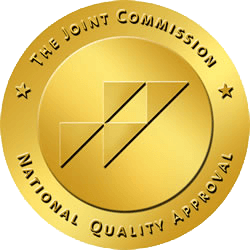Using Alcohol to Relieve Your Pain: What Are the Risks?
Discover the risks of using alcohol for pain relief and explore safer alternatives for managing discomfort.
Understanding Alcohol as Pain Relief
For some individuals, there is a misconception surrounding the use of alcohol as a method for pain relief. This misguided belief often stems from a lack of understanding about the potential risks and dangers associated with using alcohol to alleviate pain. It's important to debunk this myth and shed light on the reality of using alcohol in this manner.

The Common Misconception
One common misconception is that alcohol can effectively numb pain and provide relief from discomfort. While alcohol may initially create a sense of relaxation or euphoria, it does not address the underlying cause of the pain. Instead, it can mask the pain temporarily, leading to a false perception of relief. This temporary masking effect can potentially exacerbate the pain once the effects of alcohol wear off, leading to a cycle of dependence on alcohol for pain management.
Why People Turn to Alcohol for Pain Relief
People may turn to alcohol for pain relief for various reasons, including its sedative effects and perceived ability to dull sensations of discomfort. Additionally, the accessibility of alcohol and its cultural acceptance in some settings may contribute to its use as a quick and convenient method for coping with pain.
However, it's essential to recognize that using alcohol as a primary means of pain relief can have serious consequences on both physical and mental health. Understanding the risks and dangers associated with relying on alcohol for pain management is crucial in making informed decisions about one's well-being and exploring safer alternatives for effective pain relief.
Risks and Dangers of Using Alcohol for Pain Relief
Alcohol is often mistakenly viewed as a quick fix for pain relief, but its use for this purpose comes with significant risks and dangers that should not be overlooked.
Alcohol's Effects on Pain Perception
While alcohol may provide temporary relief by altering the perception of pain, it is essential to understand that this effect is primarily due to the numbing of senses rather than addressing the underlying cause of the pain. The sedative properties of alcohol can create a false sense of relief, masking the pain temporarily without treating the root issue.

Moreover, relying on alcohol as a pain reliever can lead to a cycle of dependence, where higher amounts of alcohol are needed to achieve the same numbing effect. This can result in a dangerous pattern of alcohol misuse and potential long-term health consequences.
Negative Health Consequences
Using alcohol as a means of pain relief poses serious health risks that extend far beyond the immediate alleviation of discomfort. Regular or excessive alcohol consumption can have detrimental effects on various bodily systems, exacerbating existing health conditions or creating new ones.

Additionally, the interaction between alcohol and certain medications commonly used for pain relief can amplify the negative effects and lead to adverse outcomes. Combining alcohol with over-the-counter or prescription pain relievers can heighten the risk of side effects, overdose, and complications.
It is crucial to recognize the risks associated with using alcohol for pain relief and seek safer alternatives that address the root cause of pain without endangering one's health and well-being. By understanding the limitations and potential harm of alcohol in managing pain, individuals can make informed decisions to safeguard their health and explore alternative pain relief methods that promote overall wellness.
Interactions with Medications
When it comes to using alcohol for pain relief, it's crucial to be aware of the potential interactions with medications, both over-the-counter (OTC) pain relievers and prescription pain medications. Mixing alcohol with certain medications can have serious consequences and may amplify the risks associated with both substances.
Alcohol and Over-the-Counter Pain Relievers
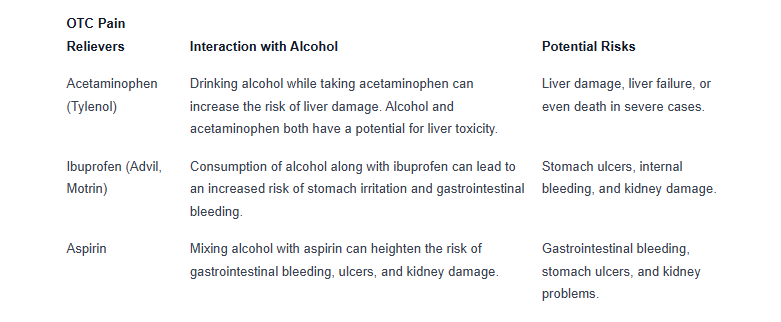
It is important to consult a healthcare provider before combining alcohol with any OTC pain relievers to avoid potential harm to your health.
Alcohol and Prescription Pain Medications
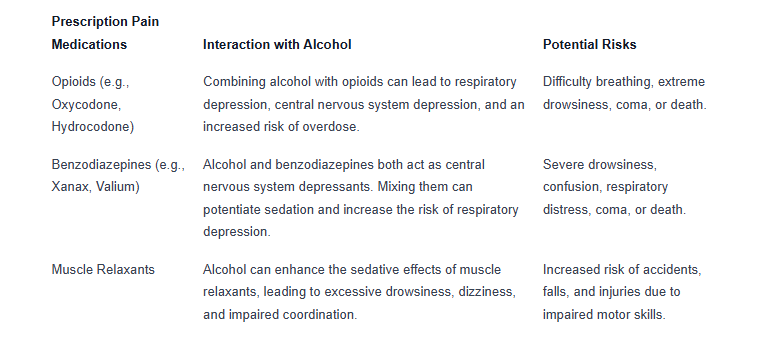
It is imperative to avoid alcohol consumption while taking prescription pain medications, as the combination can result in severe and potentially life-threatening side effects. Always follow the guidance of your healthcare provider and pharmacist to ensure safe and effective pain management.
Understanding the interactions between alcohol and medications is essential in safeguarding your health and well-being. Prioritize your safety by being informed and seeking professional advice when managing pain to avoid any adverse outcomes associated with mixing alcohol and pain relievers, whether over-the-counter or prescription medications.
Alcohol Dependence and Pain Management
When examining the relationship between alcohol dependence and pain management, it becomes evident that there exists a cycle of dependence that can significantly impact long-term pain management strategies.
The Cycle of Dependence
Alcohol dependence can create a complex cycle, especially when individuals turn to alcohol as a means of coping with pain. This cycle often begins with the temporary relief that alcohol may provide from physical or emotional pain. However, over time, the reliance on alcohol to manage pain can lead to a dangerous pattern of dependence.
Individuals experiencing chronic pain may find themselves increasingly reliant on alcohol to numb their discomfort, leading to a cycle where alcohol consumption becomes intertwined with pain management. This dependence can perpetuate the underlying issues causing the pain, while also giving rise to additional health concerns related to excessive alcohol intake.
Impact on Long-Term Pain Management
The impact of alcohol dependence on long-term pain management is significant and multifaceted. While alcohol may temporarily alleviate pain symptoms, it does not address the root cause of the pain and can even exacerbate certain conditions over time.
Long-term use of alcohol for pain relief can result in physiological dependence, tolerance, and potentially worsen pain perception in the long run. Additionally, individuals who rely on alcohol to manage pain may be less likely to seek out alternative, more effective pain management strategies that address the underlying causes of their pain.
Moreover, the negative consequences of alcohol dependence, such as liver damage, cognitive impairment, and mental health issues, can further complicate the management of chronic pain conditions. This creates a challenging cycle where alcohol dependence not only fails to provide sustainable pain relief but also contributes to a range of additional health problems that can impact overall well-being.
Understanding the cycle of dependence and its implications on long-term pain management is essential for individuals seeking to break free from the harmful pattern of using alcohol as a sole means of pain relief. By exploring safer alternatives and seeking professional guidance, individuals can take proactive steps toward managing their pain effectively while safeguarding their health and well-being in the long term.
Safer Alternatives for Pain Relief
When looking for pain relief options, it's essential to explore alternatives to using alcohol, which can have detrimental effects on both physical and mental well-being. Natural remedies for pain and non-alcoholic pain relief options provide safer alternatives that can effectively alleviate discomfort without the risks associated with alcohol consumption.
Natural Remedies for Pain
Natural remedies have long been used to manage various types of pain. These alternatives harness the power of natural ingredients to address pain symptoms without the need for alcohol. Some common natural remedies for pain relief include:
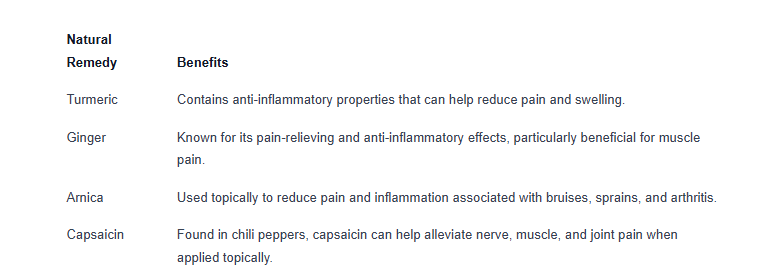
By incorporating these natural remedies into your pain management routine, you can effectively address discomfort while avoiding the risks associated with alcohol consumption. Additionally, natural remedies often come with fewer side effects, making them a safer choice for long-term pain relief.
Non-Alcoholic Pain Relief Options
In addition to natural remedies, there are various non-alcoholic pain relief options available that can provide effective relief without the need for alcohol. These alternatives range from over-the-counter pain relievers to therapeutic treatments that target pain at its source. Some non-alcoholic pain relief options include:
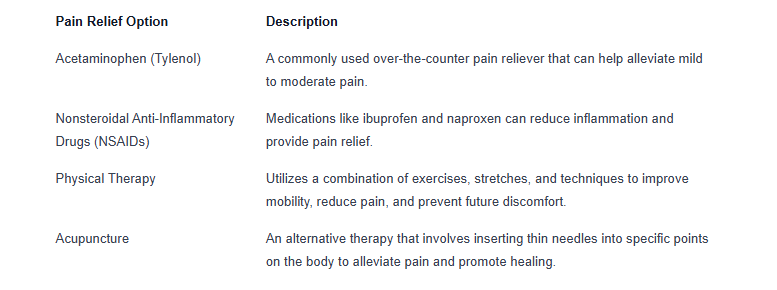
These non-alcoholic pain relief options offer a diverse range of approaches to managing pain effectively and safely. From natural remedies like meditation and gentle exercise to over-the-counter medications and physical therapy, there are numerous ways to address both chronic and acute pain without turning to alcohol. Many people find success with a combination of treatments, tailoring their approach to their specific needs and circumstances. The key is to remain open to different methods while working closely with healthcare providers to find the most effective combination.
Some individuals discover that mindfulness practices and deep breathing exercises can significantly reduce their perception of pain, while others benefit more from regular yoga or swimming sessions. Alternative therapies such as acupuncture, massage, and chiropractic care have also shown promising results for many pain sufferers. Additionally, modern advances in pain management technology, including TENS units and biofeedback devices, provide new opportunities for non-medicinal pain relief. These technological solutions are becoming increasingly accessible and user-friendly, making them viable options for home-based pain management.
By consulting with healthcare professionals and exploring these alternatives, individuals can find relief without resorting to alcohol as a pain management strategy. Healthcare providers can help develop a comprehensive pain management plan that considers the underlying causes of pain, individual health factors, and lifestyle preferences. This personalized approach not only helps manage pain more effectively but also promotes overall health and well-being without the risks associated with using alcohol for pain relief. Regular check-ins and plan adjustments ensure that the chosen strategies continue to meet changing needs and circumstances.
It's important to note that pain management is often most successful when approached holistically, considering both physical and emotional aspects of pain. This might include working with mental health professionals to address anxiety or depression that often accompanies chronic pain, making dietary modifications to reduce inflammation, and implementing stress-reduction techniques into daily routines. Support groups and pain management education programs can also provide valuable resources and coping strategies while building a community of individuals facing similar challenges.
The journey to finding effective non-alcoholic pain management solutions may take time and patience. Some people find immediate relief with certain treatments, while others need to experiment with different combinations before finding what works best for them. Environmental factors, such as workplace ergonomics and home setup, can also play a crucial role in pain management and should be evaluated as part of a comprehensive approach. Additionally, lifestyle modifications like improving sleep habits, maintaining a healthy weight, and developing better posture can contribute significantly to long-term pain reduction.
Research continues to advance our understanding of pain management, leading to new and innovative treatment options. From cutting-edge medical devices to ancient healing practices, the field of pain management is constantly evolving. Staying informed about these developments and maintaining open communication with healthcare providers can help individuals access the most current and effective treatment options available. Remember that what works for one person may not work for another, and it's perfectly normal to need to adjust and refine pain management strategies over time.
Moreover, the role of nutrition in pain management cannot be understated. Anti-inflammatory foods and supplements, when incorporated into a balanced diet, can help reduce chronic pain and improve overall well-being. Foods rich in omega-3 fatty acids, turmeric, ginger, and other natural anti-inflammatory compounds have shown promise in supporting pain management efforts. Proper hydration is also crucial, as dehydration can exacerbate pain symptoms and reduce the body's natural healing abilities.
The importance of social support in pain management deserves special attention. Family members, friends, and caregivers play vital roles in supporting individuals dealing with chronic pain. Their understanding and assistance can make a significant difference in implementing and maintaining effective pain management strategies. Educational resources and support programs designed for family members can help them better understand the challenges of chronic pain and provide more effective support.
Advanced physical therapy techniques, including specialized exercises and movement therapies, continue to show promising results in pain management. These may include methods such as the McKenzie Method, the Feldenkrais Method, or Alexander Technique, which focus on body awareness and movement patterns. Hydrotherapy and aquatic exercises offer particularly effective options for individuals who find traditional exercise challenging due to pain or mobility issues.
The integration of technology in pain management continues to expand, with smartphone apps and wearable devices now offering features like pain tracking, medication reminders, and guided relaxation exercises. These tools can help individuals better understand their pain patterns and triggers while providing valuable data to healthcare providers for more effective treatment planning. Virtual reality applications are also emerging as promising tools for pain management, offering immersive experiences that can help distract from pain and teach valuable coping strategies.
Sources
https://www.columbusrecoverycenter.com/alcohol-addiction/using-alcohol-to-ease-chronic-pain/
https://www.niaaa.nih.gov/publications/brochures-and-fact-sheets/using-alcohol-to-relieve-your-pain
https://coloradopaincare.com/the-impact-of-alcohol-on-chronic-pain/

We Are Here To Help.
Call Us Today!
%201.png)
Subscribe To Our Mailing List
%201.png)




